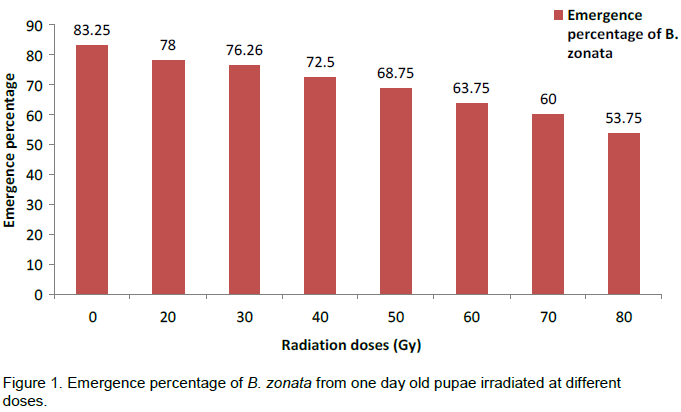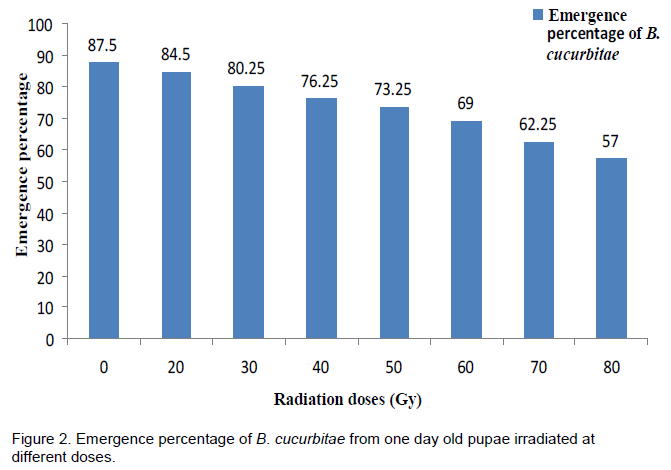ABSTRACT
Fruit flies are regarded as one of the most devastating pest of fruits and vegetables on earth planet. Generally chemical control is implemented for their control but it poses lot of eco-environmental concerns so the emphasis is now turning towards eco-friendly management practices. Bio-control is an efficient and environmentally sound approach and augmentation is primarily focus on classical biological control program. In this study, eight sub-sterilizing doses of 0, 20, 30, 40, 50, 60, 70 and 80 were tested against Bactrocera zonata and Bactrocera cucurbitae pupae. The results showed that radiation prolong the duration of pupal stage and hatching is reduced by applying radiation. This also shows that when the quantity of the radiation increases, the adult emergence decreases. This study could be very useful in exploiting the potential host for longer period of time for culturing their pupal parasitoids.
Key words: Sub sterilizing doses, radiation, fruit flies and emergence.
Abbreviation:
Fruit flies are of significant economic importance as pest in many of the important fruits. These are controlled generally by applying pesticides but these pesticides cause lot of environmental concerns and also on human health (Gill and Garg, 2014) moreover the fruit flies have attain resistance against pesticides (Van Steenwyck et al., 1975) so the focus is now diverting towards other control practices in which sterilization using radiation is an important tool. Nuclear techniques are already being practically applied convincingly in various areas of entomology (Bakri et al., 2005). These are used against the different insect pest for suppressing the activity of insects (Faruki et al., 2005). The immature stages of the insect are most likely vulnerable to radio activity (Tilton and Brower, 1983). Additionally, radiation can be applied to semi- or completely sterilize hosts or prey for deployment in the field to increase the initial survival and build-up of natural or released biological control agents in advance of seasonal pest population build-up (Hendricks et al., 2009). By applying radiations the emergence of adults decreases (Faruki et al., 2007). It is also reported that emergence of black cutworm at different radiation doses applied on egg stage decreases the hatching and induced sterility in adults, more over it prolong the larval and pupal stage of the insect (Salem et al., 2014). The objective of current is to evaluate the emergence of adult fruit flies by irradiating the pupae at different doses.
Adult emergence percentage of B. zonata and B. cucurbitae from the one day old pupae irradiated at different doses
The experiment was conducted at fruit flies rearing laboratory, Nuclear Institute of Agriculture (NIA), Tandojam, Pakistan. The pupae of two fruit fly species, Bactrocera zonata and B. cucurbitae were obtained from their respective colonies being maintained in NIA at temperature 27±2 and relative humidity about 40-45% for the last several years. Then these pupae were radiated from Nuclear Institute of Medicine and Radiopathy (NIMRA) Jamshoro which is about 60 km from NIA by using gamma radiation source of Atomic Energy of Canada Limited Co-60 Ottawa, Ontario, Canada having Model GWXJ80 with dose rate of 1.20 Gy per minute. Radiations were applied at different doses ranging from 20 to 80 Gy to one day old pupae to check the emergence of fruit flies adults. The pupae irradiated at different doses and of two different species are kept in petri dishes separately then calculate the emerged adults from the pupae, meanwhile the un-emerged and half emerged pupae are also calculated. Data analyzed statistically using variance followed by DMRT test by using statistical software statistix 8.1.
Adult emergence percentage of B. zonata and B. cucurbitae from the one day old pupae irradiated at different doses
The emergence of the fruit flies, B. zonata and B. cucurbitae was affected significantly with increase in radiation doses applied (Table 1). The emergence percentage of B. zonata and B. cucurbitae was at its peak 83.25 and 87.50, respectively when no dose of radiation was applied to the pupae. Among different radiation doses, the treatment of 20 Gy resulted in highest emergence percentage, 78% of B. zonata and 84.50% of B. cucurbitae. The emergence percentage decreased gradually with the increase in radiation doses and with the subsequent doses of 30, 40, 50, 60 and 70 Gy the emergence percentage of B. zonata was 76.26, 72.50, 68.75, 63.75 and 60.0% while that of B. cucurbitae was 80.25, 76.25, 73.25, 69.0 and 62.25%, respectively. This decreasing trend in the emergence of both the fruit fly species is clearly visible in the bar series of Figures 1 and 2. Significantly the least number of adults of both species of the fruit flies (53.75 and 57, respectively) were emerged when 80 Gy radiation dose was applied to the host pupae. The present studies reflected that emergence of fruit flies is negatively correlated with the radiation doses and higher doses of



irradiation applied to the pupae resulted in lower emergence percentage of the fruit fly adults. The radiation effect was comparatively higher on B. zonata pupae as compared to the B. cucurbitae as the emergence of the B. cucurbitae was relatively higher at all the radiation doses tested including the un-treated control (Figure 3). The results indicated a gradual decrease in the fruit fly adult emergence with the increase in the radiation doses applied.
These studies indicated a wide range of tolerances in the usage of irradiation for rearing of the fruit fly pupal parasitoids. However, the emergence of the adult fruit flies decreased with the increasing doses of radiation. Similar results were reported by Lo´ pez-Mart?´nez and Hahn (2014). This may be very useful in reducing the chance of releasing the fertile fruit flies in the target areas that may have been left un-parasitized in the parasitoid rearing colony. The emergence of the adult fruit flies from the B. cucurbitae was comparatively higher than the B. zonata that may be due to the size of the pupae. As the effects of the radiation appears interrelated to the size of the pupae and the pupal size of the B. cucurbitae is bigger than B. zonata which resulted comparatively higher number of B. cucurbitae adult emergence at same radiation doses than B. zonata. Similar finding was observed by Bustos et al., (1992). Their studies provided significant support for irradiation of hosts before exposing to the parasitoids. The emergence of the parasitoids from the irradiated fruit fly pupae clearly demonstrated that the use of irradiated pupae (host) does not depict any negative effect on parasitoids. A number of studies conducted in Mexico have demonstrated a very high efficiency of the parasitoids cultured on irradiated hosts (Montoya et al., 2000).
Moreover the present studies showed higher parasitism on irradiated pupae at the dose of 40 to 50 Gy in comparison to the un-irradiated pupae.
Radiations significantly decrease the emergence of the host pupae of both fruit flies species and these pupae can be efficiently exploited for the rearing of bio-control agents and these pupae can be utilized for longer time period as compared with normal pupae due to slow development of the host after applying radiation.
The authors did not declare any conflict of interest.
REFERENCES
|
Bakri A, Heather N, Hendrichs J, Ferris I (2005). Fifty years of radiation biology in entomology: lessons learned from IDIDAS. Ann. Ent. Soc. Am. 98:1-18.
Crossref
|
|
|
|
Bustos RE, Enkerlin W, Toledo J, Reyes J, Casimiro A (1992). 'Irradiation of mangoes as a quarantine treatment' in Use of Irradiation as a Quarantine Treatment of Food and Agricultural Commodities, IAEA, vienna, Austria. pp. 77-90.
|
|
|
|
|
Faruki SI, Das DR, Khatun S (2005). Effects of UV-radiation on the larvae of the lesser mealworm, Alphitobius diaperinus (Panzer)(Coleoptera: Tenebrionidae) and their progeny. Pak. J. Biol. Sci. 5:444-448.
Crossref
|
|
|
|
|
Faruki, SI, Das DR, Khan AR, Khatun M (2007). Effects of ultraviolet (254nm) irradiation on egg hatching and adult emergence of the flour beetles, Tribolium castaneum, T. confusum and the almond moth, Cadra cautella. J. Ins. Sci, 7(36): 1-6.
Crossref
|
|
|
|
|
Gill HK, Garg H (2014). Pesticide: Environmental Impacts and Management Strategies, pp. 187-230. In: Solenski S, Larramenday ML (eds.). Pesticides- Toxic Effects. Intech. Rijeka, Croatia.
|
|
|
|
|
Hendrichs J, Bloem K, Hoch G, Carpenter JE, Greany P, Robinson AS (2009). Improving the cost – effectiveness, trade and safety of biological control for agricultural insect pests using nuclear techniques. Biocontrol Sci. Technol. 19(1):3-22.
Crossref
|
|
|
|
|
Lo´ pez-Martı´nez G, Hahn DA (2014). Early Life Hormetic Treatments Decrease Irradiation-Induced Oxidative Damage, Increase Longevity, and Enhance Sexual Performance during Old Age in the Caribbean Fruit Fly. PLoS ONE 9(1):1-11.
|
|
|
|
|
Montoya P, Liedo P, Benrey B, Cancino J, Barrera JF, Sivinski J, Aluja M (2000). Biological control of Anastrepha spp. (Diptera: tephritidae) in mango orchards through augmentative releases of Diacasmimorpha longicaudata (Ashmead) (Hymenoptera: Braconidae). Biol. Control. 18: 216-224.
Crossref
|
|
|
|
|
Salem HM, Fouda MA, Abas AA, Ali WM, Gabarty A (2014). Effects of gamma irradiation on the development and reproduction of the greasy cutworm, Agrotis ipsilon (Hufn.). J. Rediat. Res. Appl. Sci. 7:110-115.
Crossref
|
|
|
|
|
Van Steenwyck RA, Toscano NC, Bollmer GR, Kido K, Reyonolds HT (1975). Increase of Heliothis spp. in cotton under various insecticide treatment regimes. Environ. Entomol. 4: 993-996.
Crossref
|
|